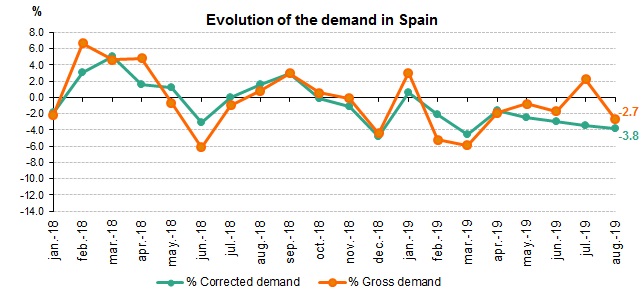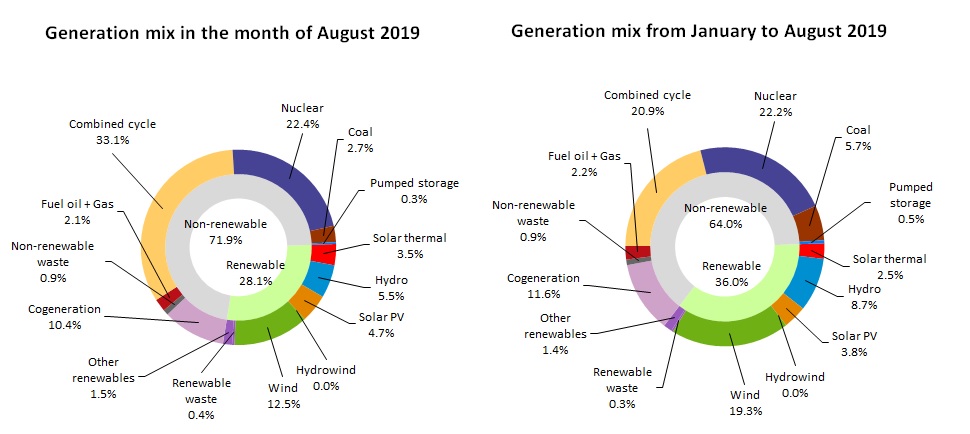- 28.1% of the total generation in Spain in August came from renewable sources and more than half of this figure was generated using technologies which produce zero CO2 emissions. In the first eight months of the year, renewable energy covered 36% of the total generation.
- Demand on the Balearic Islands increased 0.6% compared to the same month last year.
- Renewable generation on the Canary Islands produced 23.2% of the electricity demanded in the archipelago.
The demand for electrical energy nationwide in the month of August was estimated at 22,883 GWh, 2.7% higher than that registered in the same month last year. After having factored in the influence of seasonal and working patterns, the demand for electricity fell 3.8% compared to August 2018.
In the first eight months of 2019, the demand for electricity is estimated at 177, 896 GWh, 1.6% less than in 2018. Again, after having factored in the influence of seasonal and working patterns, the demand for electricity is 2.6% lower than that registered in the same period last year.

During the month of August and according to current estimated data, generation coming from renewable energy sources represented 28.1% of the total production. In the first eight months of the year, renewable energy represented 36% of the total electricity generation mix nationwide.
50.8% of electricity generation during the month was obtained using technologies which produce zero CO2 emissions.
With information available as at the time of this press release, wind energy generation in August reached 2,831 GWh, 9.6% down on the same period last year, and accounted for 12.5% of the total production in Spain.

Demand for electrical energy in the peninsular electricity system falls by 2.9%.
Demand for electrical energy in the peninsular electricity system in the month of August is estimated at 21,354 GWh, 2.9% lower than that recorded in the same month last year. After having factored in the influence of seasonal and working patterns, the demand for electricity fell by 4.2% compared to August 2018.
In the first eight months of 2019, the demand for electricity on the Spanish Peninsula is estimated at 167,550 GWh, 1.7% less than in 2018. Again, after having factored in the influence of seasonal and working patterns, the demand for electricity is 2.7% lower than that registered in the same period last year.
During August and according to current estimated data, 28.8% of the peninsular generation came from renewable energy sources and 53% was obtained using technologies which produce zero CO2 emissions. Furthermore, wind energy in August stood at 2,672 GWh, a figure that is 12.9% lower than in August last year and contributed 12.5% to the generation mix.
Demand for electrical energy increases in the Balearic Islands and drops in the Canary Islands in August
In the Balearic Islands, the demand for electricity in August is estimated at 708,096 MWh, 0.6% up on that recorded in the same month last year. After having factored in the influence of seasonal and working patterns, the figure increased by 2.4% with respect to August 2018. In the first eight months of 2019, the demand on the Balearic Islands is estimated at 4,211,659 MWh, which is 0.6% more than in the same period in 2018.
Coal-fired generation, with 48.5% of the total, was the leading source of electricity generation in the Balearic Islands. Renewables and those technologies that produce zero CO2 emissions accounted for 4.8% of the total generation on the Balearic Islands.
Regarding the Canary Islands, demand for electricity is estimated at 779,450 MWh, 0.4% lower than that registered in August 2018. After having factored in the influence of seasonal and working patterns, the figure falls 1% compared to that of the same month last year. From January to August, demand on the Canary Islands is estimated at 5,855,324 MWh, showing an increase of 0.3% compared to the same period in 2018.
In the month of August and according to estimated data, combined cycle was the leading technology in the Canary Islands’ generation mix, with a contribution of 37.3%. Renewables and those technologies that produce zero CO2 emissions accounted for 23.2% of the generation on the Canary Islands.
Consult our Daily Balance Report for more information on the National, Peninsular, Balearic Islands and Canary Islands electricity systems as at the close of August.